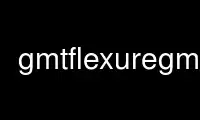
This is the command gmtflexuregmt that can be run in the OnWorks free hosting provider using one of our multiple free online workstations such as Ubuntu Online, Fedora Online, Windows online emulator or MAC OS online emulator
PROGRAM:
NAME
gmtflexure - Compute flexural deformation of 2-D loads, forces, bending and moments
SYNOPSIS
gmtflexure rm/rl[/ri]/rw -ETe[u]|D|file [ [l|r][/args] ] [ pPoisson ] [ yYoung ] [ force ]
[ args] [ ] [ wfile] [ [level] ] [ wd] [ zm] [ -bi<binary> ] [ -i<flags> ] [ -o<flags> ]
Note: No space is allowed between the option flag and the associated arguments.
DESCRIPTION
gmtflexure computes the flexural response to 2-D loads using a range of user-selectable
options, such as boundary conditions, pre-existing deformations, variable rigidity and
restoring force, and more. The solutions are obtained using finite difference
approximations to the differential equations.
REQUIRED ARGUMENTS
-Drm/rl[/ri]/rw
Sets density for mantle, load, infill (optionally, otherwise it is assumed to equal
the load density), and water. If ri is not given then it defaults to rl.
-ETe[u]|D|file
Sets the elastic plate thickness (in meter); append k for km. If the elastic
thickness exceeds 1e10 it will be interpreted as a flexural rigidity D instead (by
default D is computed from Te, Young's modulus, and Poisson's ratio; see -C to
change these values). Alternatively, supply a file with variable plate thicknesses
or rigidities. The file must be co-registered with any file given via -Q.
OPTIONAL ARGUMENTS
-A[l|r]bc[/args]
Sets the boundary conditions at the left and right boundary. The bc can be one of
four codes: 0 selects the infinity condition, were both the deflection and its
slope are set to zero. 1 selects the periodic condition where both the first and
third derivatives of the deflection are set to zero. 2 selects the clamped
condition where args (if given) sets the deflection value [0] (and its first
derivative is set to zero), while 3 selects the free condition where args is given
as moment/force which specify the end bending moment and vertical shear force
[0/0]. Use SI units for any optional arguments.
-CpPoisson
Change the current value of Poisson's ratio [0.25].
-CyYoung
Change the current value of Young's modulus [7.0e10 N/m^2].
-Fforce]
Set a constant horizontal in-plane force, in Pa m [0]
-Qn|q|t[args]
Sets the vertical load specification. Choose among these three options: -Qn means
there is no input load file and that any deformation is simply driven by the
boundary conditions set via -A. If no rigidity or elastic thickness file is given
via -E then you must also append min/max/inc to initiate the locations used for the
calculations. Append + to inc to indicate the number of points instead.
-Qq[loadfile] is a file (or stdin if not given) with (x,load in Pa) for all
equidistant data locations. Finally, -Qt[topofile] is a file (or stdin if not
given) with (x,load in m or km, positive up); see -M for topography unit used [m].
-S Compute the curvature along with the deflections and report them via the third
output column [none].
-Twfile
Supply a file with pre-existing deformations [undeformed surface].
-Wwd Specify water depth in m; append k for km. Must be positive [0]. Any subaerial
topography will be scaled via the densities set in -D to compensate for the larger
density contrast with air.
-Zzm Specify reference depth to flexed surface in m; append k for km. Must be positive
[0]. We add this value to the flexed surface before output.
-V[level] (more ...)
Select verbosity level [c].
-bi[ncols][t] (more ...)
Select native binary input.
-icols[l][sscale][ooffset][,...] (more ...)
Select input columns (0 is first column).
-ocols[,...] (more ...)
Select output columns (0 is first column).
-^ or just -
Print a short message about the syntax of the command, then exits (NOTE: on Windows
use just -).
-+ or just +
Print an extensive usage (help) message, including the explanation of any
module-specific option (but not the GMT common options), then exits.
-? or no arguments
Print a complete usage (help) message, including the explanation of options, then
exits.
--version
Print GMT version and exit.
--show-datadir
Print full path to GMT share directory and exit.
NOTE ON UNITS
The -M option controls the units used in all input and output files. However, this option
does not control values given on the command line to the -E, -W, and -Z options. These
are assumed to be in meters unless an optional k for km is appended.
PLATE FLEXURE NOTES
We solve for plate flexure using a finite difference approach. This method can accommodate
situations such as variable rigidity, restoring force that depends on the deflection being
positive or negative, pre-existing deformation, and different boundary conditions.
EXAMPLES
To compute elastic plate flexure from the topography load in topo.txt, for a 10 km thick
plate with typical densities, try
gmt flexure -Qttopo.txt -E10k -D2700/3300/1035 > flex.txt
REFERENCES
Use gmtflexuregmt online using onworks.net services
